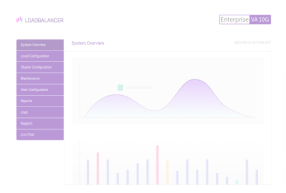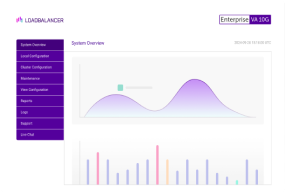
The cybersecurity community was shaken last week when F5 disclosed that a highly sophisticated nation-state threat actor had maintained long-term, persistent access to its network and exfiltrated files containing portions of BIG-IP source code and information about undisclosed vulnerabilities.
As engineers in the load balancing space, this incident demands our attention—not just because it affects a major competitor, but because it highlights vulnerabilities that could impact the entire infrastructure security ecosystem.
Want to strengthen your security posture?
We're here to help
How the F5 breach unfolded
The state-backed hackers broke into F5's systems in late 2023 and remained undetected until being discovered in August 2025—that's more than 12 months. Scary stuff.
F5 themselves learned of the breach on August 9, 2025, but delayed public disclosure at the request of the U.S. Department of Justice for obvious reasons.
The breach has been attributed to state-backed hackers from China, with Bloomberg reporting that the intrusion involved the use of a malware family dubbed BRICKSTORM, which is attributed to a China-nexus cyber espionage group tracked as UNC5221.
What was compromised
The scope of the breach is particularly concerning for a number of reasons:
- Source code theft: Attackers stole source code from F5's BIG-IP suite of products and information about undisclosed vulnerabilities.
- Long-term access: The threat actors had access to F5's product development environment and engineering knowledge management platforms.
- Intelligence advantage: CISA warned that the nation-state affiliated cyber threat actor's exfiltration of BIG-IP proprietary source code and vulnerability information provides the actor with a technical advantage to exploit F5 devices and software.
The immediate response
The severity of this breach triggered an unprecedented government response.
CISA issued Emergency Directive 26-01, requiring Federal Civilian Executive Branch agencies to apply the latest vendor-provided updates for at-risk F5 virtual and physical devices by October 22, 2025. CISA characterized the threat as posing an imminent risk, with the potential for threat actors to exploit vulnerabilities in F5 products. And using them to gain unauthorized access to embedded credentials and API keys, move laterally within organizations' networks, exfiltrate sensitive data, and establish persistent system access.
Scale of the F5 exposure
The numbers paint a sobering picture of the potential attack surface:
- Cortex Xpanse identifies over 600,000 F5 Big-IP instances exposed to the internet.
- Shadowserver Foundation tracked more than 266,000 F5 BIG-IP instances exposed online.
- Figures from Palo Alto Networks suggest that more than 600,000 F5 network security devices running BIG-IP software are unpatched and potentially vulnerable.
F5 critical vulnerabilities disclosed
F5 have subsequently released patches for several high-severity vulnerabilities, including:
- CVE-2025-53868: A BIG-IP SCP and SFTP vulnerability with a CVSS score of 8.7.
- CVE-2025-61955: An F5OS vulnerability with a CVSS score of up to 8.8 in appliance mode.
- CVE-2025-57780: An F5OS vulnerability with a CVSS score of up to 8.8 in appliance mode.
Key lessons for the industry
As infrastructure providers at Loadbalancer.org, this incident reinforces several critical security principles:
1. Defense in depth security is non-negotiable
A year-long breach demonstrates that perimeter security alone is insufficient. Organizations need robust internal segmentation, continuous monitoring, and assume-breach mentality.
2. Supply chain security matters
F5's BIG-IP suite is commonly used by large organizations, primarily in the U.S. but also globally, for availability, access control and security, with government agencies and Fortune 500 companies relying on BIG-IP. When infrastructure providers are compromised, the downstream impact can be catastrophic.
3. The risks of single-vendor dependency
This breach highlights a critical vulnerability that many organizations overlook: single-vendor dependency. When your entire load balancing infrastructure relies on a single vendor's architecture, a compromise of that vendor's systems can expose your entire fleet to coordinated attacks.
The theft of BIG-IP source code means attackers now have intimate knowledge of the platform's inner workings, potentially enabling them to develop zero-day exploits that could compromise entire F5 deployments simultaneously. Organizations running homogeneous F5 environments face a particularly acute risk. If attackers develop an exploit chain, they could potentially compromise the entire infrastructure at once.
4. Zero trust architecture is essential
The year-long breach underscored the need to shift to zero trust adoption. Traditional network perimeters are no longer sufficient against sophisticated nation-state actors.
5. Patch management is critical
The hundreds of thousands of unpatched F5 devices exposed to the internet represent a massive attack surface. Organizations must prioritize timely patching, especially for internet-facing infrastructure.
6. Threat detection capabilities must evolve
The fact that sophisticated attackers maintained access for 12 months undetected highlights the need for advanced threat detection, behavioral analytics, and continuous security monitoring.
The security case for multi-vendor architecture
In cybersecurity, monoculture is dangerous. Just as agricultural monocultures are vulnerable to single diseases that can wipe out entire crops, technology monocultures create systemic risk. When every load balancer in your infrastructure runs the same codebase, a single vulnerability or exploit can compromise your entire application delivery tier.
A mixed-vendor approach provides several security advantages:
- Reduced blast radius: A vulnerability in one vendor's platform doesn't expose your entire infrastructure
- Architectural diversity: Different code bases mean different attack surfaces, making it exponentially harder for attackers to develop universal exploits
- Resilience against vendor compromise: Even if one vendor suffers a breach like F5's, your alternative platforms remain secure
- Defense against zero-days: Attackers would need multiple zero-day exploits to compromise a heterogeneous environment
- Business continuity: If one vendor faces extended security incidents requiring device isolation, you can shift traffic to alternative platforms
How Loadbalancer.org solutions address these challenges
At Loadbalancer.org, we've built our products with these exact scenarios in mind. Two of our solutions are particularly relevant in light of the F5 breach:
The ADC Portal: Unified visibility and vulnerability management
Managing a multi-vendor infrastructure can be complex, but that complexity shouldn't compromise security. The ADC Portal provides centralized management and monitoring across your entire load balancing fleet, including F5 devices alongside Loadbalancer appliances.
Key capabilities for security management
- Unified Dashboard: Monitor all your load balancers from a single pane of glass, regardless of vendor
- Vulnerability Tracking: Stay on top of CVEs and security advisories across your entire fleet with centralized vulnerability management
- Patch Status Monitoring: Quickly identify which devices are running outdated firmware or missing critical security patches
In the wake of the F5 breach, organizations with Portal deployed would have immediate visibility into which F5 devices required patching, their current firmware versions, and could prioritize remediation efforts based on exposure and risk.
Loadbalancer.org Enterprise GSLB: Multi-Vendor Global Load Balancing
One of the most powerful security strategies is architectural diversity. The Loadbalancer Enterprise features advanced Global Server Load Balancing (GSLB) that works seamlessly across multiple vendor platforms, enabling true multi-vendor resilience.
Strategic security benefits
- Vendor-Agnostic Architecture: Deploy GSLB across Loadbalancer.org appliances, F5 devices, and other vendor platforms simultaneously
- Intelligent Traffic Distribution: Automatically route traffic away from compromised or vulnerable platforms during security incidents
- Zero-Trust Traffic Steering: Make real-time load balancing decisions based on security posture, not just performance metrics
- Rapid Incident Response: If a security advisory affects one vendor's platform, instantly shift production traffic to alternative infrastructure
- Geographic Distribution: Spread risk across different vendors in different data centers and cloud regions
A real-world scenario
Imagine CISA issues an emergency directive affecting your F5 fleet (as they just did). With Enterprise GSLB, you can:
- Immediately shift critical production traffic to your Loadbalancer appliances
- Take F5 devices offline for emergency patching without service disruption
- Gradually restore F5 devices to production after verification
- Maintain full redundancy throughout the incident response
This isn't theoretical. It's exactly the kind of resilience that separates organizations that survive major security incidents, from those that suffer outages and breaches.
Our commitment to security
At Loadbalancer.org, we understand that our customers trust us with their most critical infrastructure. This incident reinforces our commitment to:
- Transparent security practices: Maintaining open communication with customers about security posture and any incidents.
- Rapid response capabilities: Having incident response plans ready to detect and contain threats quickly.
- Secure development lifecycle: Incorporating security at every stage of product development.
- Regular security updates: Providing timely patches and security updates to address emerging threats.
- Interoperability by design: Building solutions that enhance rather than replace your existing infrastructure investments.
Enterprise security recommendations
If you're running load balancing or application delivery infrastructure:
- Inventory your assets: Know exactly what devices you have exposed to the internet—Portal can automate this discovery.
- Apply updates immediately: Don't delay critical security patches, and use centralized management to track patch status.
- Evaluate architectural diversity: Consider whether single-vendor dependency creates unacceptable risk.
- Implement network segmentation: Limit lateral movement opportunities for attackers.
- Enable comprehensive logging: Ensure you can detect and investigate suspicious activity across all platforms.
- Review access controls: Implement least-privilege access and multi-factor authentication.
- Consider zero trust architecture: Evaluate moving toward a zero-trust security model.
- Plan for vendor incidents: Develop runbooks for rapidly shifting traffic away from compromised platforms.
- Deploy multi-vendor GSLB: Build resilience through architectural diversity.
- Monitor for anomalies: Look for unusual access patterns, especially on management interfaces.
Moving forward: Building resilient infrastructure
The F5 breach serves as a stark reminder that no organization, regardless of size or security focus is immune to sophisticated nation-state attacks. F5's stock dropped 10% following the disclosure, demonstrating that security breaches carry significant business consequences.
But this incident also presents an opportunity. Organizations can emerge stronger by:
- Embracing architectural diversity as a security strategy, not just a redundancy measure.
- Deploying unified management to handle the complexity of multi-vendor environments.
- Implementing intelligent traffic steering that considers security posture in load balancing decisions.
- Building incident response capabilities that leverage multi-vendor flexibility.
The most resilient organizations don't put all their eggs in one basket. They build infrastructure that can withstand not just technical failures, but vendor compromises, supply chain attacks, and coordinated nation-state campaigns.
Conclusion
For the load balancing and infrastructure community, this incident should prompt a thorough review of security practices, patch management processes, detection capabilities, and critically vendor dependency risk.
At Loadbalancer.org, we remain committed to learning from industry incidents, continuously improving our security posture, and providing our customers with infrastructure they can trust.
Our ADC Portal and Enterprise GSLB solutions are designed specifically to help organizations build more secure, more resilient, and more manageable infrastructure. Even in a world where major vendors can be compromised.
The question isn't whether another major vendor will suffer a breach — it's whether your infrastructure can survive it.
















